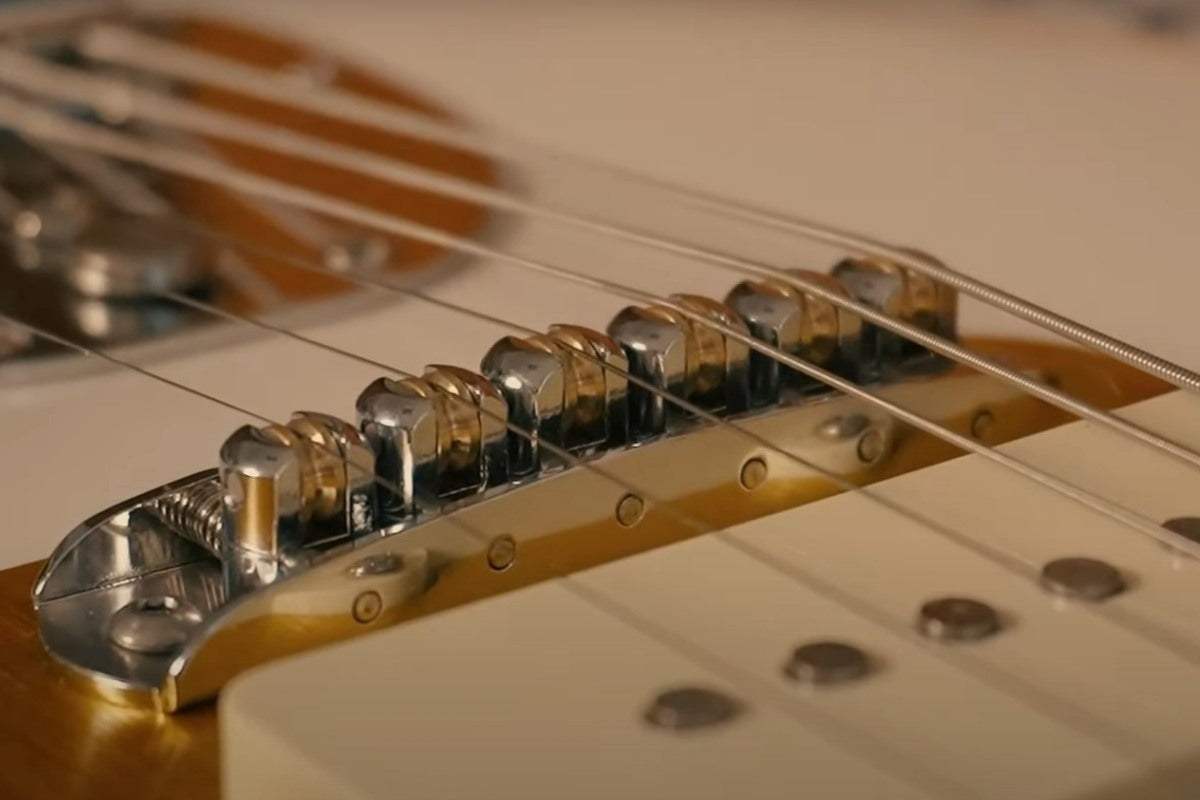If chords are the building block of music (see c chord on guitar if you're interested), then scales are the cement that holds them together. Scales allow you to create melodies, and add harmonies, as well as construct solos and improvise, making them an incredibly important part of your musical vocabulary.
But scales are associated with the two words that put fear into the heart of any guitarist… music theory. Therefore, as with anything theoretical, most of us would rather avoid them, they sound boring when you play them, so practicing them isn’t fun.
However, that doesn’t have to be the case, and there are fun ways to learn scales as you’ll find out soon, but before that, let’s get started with the basics…
What is a Pentatonic Scale?
Being a ‘Pent’-a-’ton’-ic scale, we need to think in terms of ‘pent’ and ‘ton’.
You can find Pent all over the place. You have the Pentathlon, which as all good Olympians will know contains five different sports. Then there is the Pentagon, which all politicians recognize as a very strangely designed five-sided government building. You may also know of a Pentacle, which is a five-sided star, the common thread is therefore the number Five.
Ton comes from the Latin word Tonus, which means sound or tone. Therefore a ‘Pent’-a-’ton’-ic scale is a Five-Tone scale, and therefore contains five (pent) tones (tonic) per octave.
It can be constructed in any major or minor key, but to keep things relatively simple, I will concentrate on major pentatonic scales. These scales use the five most basic tones found in most simple songs and folk melodies.
Sorry, but it’s now time for a little bit of theory…
We all know that music theory is boring, but you do need to at least get your head around some of it. So… any major scale contains seven notes - doh-ray-me-fah-so-etc., as the classic song from The Sound Of Music goes on and on about.
To make a major pentatonic scale from a major scale, you remove the 4th degree (4th note) as well as the 7th degree (the 7th note), and you will then be left with a five-note scale - the major pentatonic.
What does a Pentatonic Scale sound like?
The pentatonic is a very pleasant and distinct-sounding scale that works incredibly well when layered over chords. It has no half-steps between the notes, which sets it apart from major or minor scales.
It is widely used by many, if not most guitar legends. In fact, it’s basically been used at some point by every serious player who has ever played a solo. Some famous guitarists hardly ever use anything else, to be honest.
David Gilmour's solos in Comfortably Numb, Time, Another Brick in the Wall, and many more legendary Pink Floyd songs use predominantly Pentatonic scales
But, if it’s so simple, it must be boring...
Not at all, its simplicity is what makes it so useful, it’s really hard to go wrong with pentatonic, so it’s the best scale to use for jamming or live performances if you're playing an unfamiliar or unrehearsed song.
So what makes the pentatonic scale sound so good?
Sorry, but it’s time for some more of that horribly boring theory again, I promise I’ll keep it short and sweet.
When you play a major scale, the fourth degree (that’s the fourth note of the scale) and the seventh degree (guess what! That’s the seventh - you see, theory is far easier than you think) form a tritone. This creates an interval within the scale that produces a feeling of suspense and tension.
But, pentatonic scales don’t contain either the fourth or the seventh degrees. They, therefore, can’t form the dramatic tritone, which can not be heard within the scale, making it sound more harmonious.
The live version of Pink Floyd’s Comfortably Numb shows how wonderful Pentatonic scales can sound
Scale Wars - Pentatonic vs. Major
The pentatonic is usually the first scale that beginners learn on the guitar. It is easily the simplest to play and by far, the most commonly used.
Unfortunately, many guitarists consider it the ‘mini-me’ version of the Major Scale. But even though it contains fewer notes than the major, it’s just as useful in terms of versatility and playability. However, the major scale is still the King in terms of understanding and applying music theory, because everything is derived from it.
The pentatonic has been in use as far back as music existed, there are even musical instruments that are believed to be 50,000 years old that have been found tuned to it.

University of Tubingen
Gregorian chants (that’s the weird singing that Monks used to do) are built on pentatonic melodies, and different forms of the scale have been found in the cultures and traditional music of Native Americans, as well as being widespread across Africa, as far as Southern Asia.
If you compare that to the Major Scale, then that’s the ‘baby’ of the two - it only started becoming popular in the 16th century.
But, Who Uses the Pentatonic Now?
In a word, everyone! Traditional and folk music developed and turned into gospel, jazz, bluegrass, and obviously, modern folk music. The pentatonic was always the basis. These styles then evolved and turned into modern blues, rock, and pop.
The Pentatonic Scale and Modern Rock Music
The popularity of the pentatonic in rock and blues is evident and justified, this is because of how fantastic it sounds when played over almost anything.
Using the pentatonic scale for soloing over chord progressions is very common in rock, and is a great way for beginners to start improvising quickly.
But, why is the Pentatonic so useful...
Versatility when Improvising
You can play the pentatonic scale over any major chord progression within the same key. But, amazingly, you can also play it over any minor chord progression, or over a 12-bar blues progression. In fact, it can be played over just about anything.
Play it along with an instrumental section from any of your favorite songs or over any backing track. You’ll instantly see how amazing it is!
It’s Easy To Play
All the fingerings are simple, using only two notes per string. After you’ve remembered them, which shouldn’t take you very long at all, you can then use and transpose them effortlessly between the different keys.
How to Play the Pentatonic Scale
The best thing about the pentatonic scale is how easy it is to play. So, let’s explore the different shapes of the pentatonic on the fretboard. The diagram below shows the notes of the first position C major Pentatonic.

And, that can be expanded to include all five positions (seven if you extend them) of the C major Pentatonic Scale. These are shown in the diagram below:

Memorizing and practicing the patterns is the real key to unlocking the power of the pentatonic scale. Once you know them all, simply move the patterns up or down the fretboard to transpose the scale to any other key.
Fragment Patterns
In the intro I mentioned a fun way to learn scales, well, let me introduce you to fragment patterns. These are mathematical ways of splitting up the scale to give you more interesting fingerings and make the scale sound more musical when you are practicing it.
The most basic fragment is a 1-2-3. Start by playing the first three notes of the C Major Pentatonic scale (position 1), now return to the second note and play that followed by the next two notes of the scale, i.e. 1-2-3 starting from the second note. Now go back to the third note and play 1-2-3 from there, then the fourth note, 1-2-3 from there. Continue doing this until you reach the last note of the scale on the high e-string.
As opposed to playing 12 notes, as you would do if you play the scale normally, you have played 30 notes, used much more interesting and useful fingerings, and the scale sounded a lot cooler!
To go back down the strings, start on the highest note of the scale and play the pattern in reverse until you return to the root C note.
Once you get the hang of that…
When you master this, you can now make things a little bit more difficult for yourself, try reversing the pattern, i.e. 3-2-1, or really mixing it up - 2,1,3. Or add more notes in the sequence 1-2-3-4, then mix them up 2-4-1-3. It’s up to your imagination to continually create harder sequences as you improve over the years.
Plus, you can use fragment patterns on all other scales and modes, making them more fun to practice as well.
Wrapping It Up
If you consider how often pentatonic scales are used, and the special place they have in nearly every genre of modern mainstream music, the scale’s usefulness simply can’t be overstated.
Learn all the patterns I’ve covered one at a time, making sure you can play them perfectly, and then practice moving between them. After you’ve learned the first pattern, use it to improvise over your favorite songs or backing tracks. Obviously, make sure that you are in the correct key.
Follow these simple steps, and your playing, especially your ability to improvise will improve massively as you let the magic that is the pentatonic scale shine through.
If you like this article, please share it!
Be sure to join our FB Group Guyker Guitar Parts VIP Group to share your ideas! You can also have connections with like-minded guitar players, Guyker updates as well as discounts information from our FB Group.







